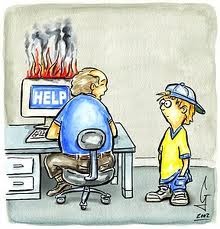Unless you try to do something beyond what you have already mastered, you will never grow. Ronald E. Osborn
Friday, March 23, 2012
Friday, March 2, 2012
how would i use blogs,wikis and delisious with my EFL students?
Blogs are a very interested
website that I can use to bound a good relation with my students that lead to a
better teaching and learning in and outside the class. For example:
I can give my students
some homework s or reading and ask for their
opinion, or they can post their own material that they think it has relation to
our topic and we (the rest of the class and me ) can add our comments.I can also post an extra reading that are related to the previous topic we had in class and ask them to read ,reflect and add their own comments
on wiki , I can give my students some interested learning games or online tests.
For delicious I can ask them to subscribe in some English teaching website to help them improving their English . It will be a good use of online materials like videos or online teaching websites .
I can even chose one
class a week that we take it in the lap
and start working on all of these three websites .
it will be a great add to my teaching style that will keep
students ore interested ,and keep me more aware of my students progress .
Digital Natives, Digital Immigrants
I consider myself a digital native because I grew up using this new technology . According to Marc Prensky , we have spent our entire lives surrounded by and using computers, videogames, digital music players, video cams, cell phones, and all the other toys and tools of the digital age. Unlike us , Those who were not born into the digital world but have, at some later point in their lives are digital immigrants.
Digital Natives are used to receiving information really fast and they prefer random access , graphics before their text, and games to “serious” work . They function best when networked. But digital Immigrants are more typically have very little appreciation for these new skills, they learned – and so choose to teach – slowly, step-by-step, one thing at a time, individually, and above all, seriously.
Sometimes digital immigrants tend to print out a document written on the computer in order to edit it (rather than just editing on the screen); or bringing people physically into your office to see an interesting web site (rather than just sending them the URL). They even might call you to make sure that you received a certain email. This is what mark called accent ,which is what digital immigrants bring back from their foot in the past .
Should the Digital Native students learn the old ways, or should their Digital Immigrant educators learn the new?. This is what Prensky thought is the biggest serious problem facing education today. In order to try to confront this issue , he thought that we need to reconsider both our methodology and our content.
First, our methodology. Today‟s teachers have to learn to communicate in the language and style of their students. This doesn’t mean changing the meaning of what is important,
or of good thinking skills. But it does mean going faster, less step-by step, more in parallel, with more random access, among other things
Second, our content. There are now two kinds of content: “Legacy” content (to borrow the computer term for old systems) and “Future” content.
“Legacy” content is all of our “traditional” curriculum. It is of course still important, but it is from a different era. Some of will continue to be important, but will become less.
“Future” content is to a large extent, not surprisingly, digital and technological. But while it includes software, hardware, robotics, nanotechnology, genomics, etc. it also includes the ethics, politics, sociology, languages and other things that go with them. This “Future” content is interesting to today's students . Marc thought it's a brilliant idea if we let kids to be allowed to use computers only in school .
Prensky thinks that we need to be thinking about how to teach both Legacy and Future content in the language of the Digital Natives. we have to invent, but not necessarily from scratch. Adapting materials to the language of Digital Natives has already been done successfully. His own preference for teaching Digital Natives is to invent computer games to do the job, even for the most serious content.
So if Digital Immigrant educators really want to reach Digital Natives – i.e. all their students – they will have to change. It's high time for them to stop their grousing, and as the Nike motto of the Digital Native generation says, “Just do it!” They will succeed in the long run – and their successes will come that much sooner if their administrators support them.
Subscribe to:
Posts (Atom)






